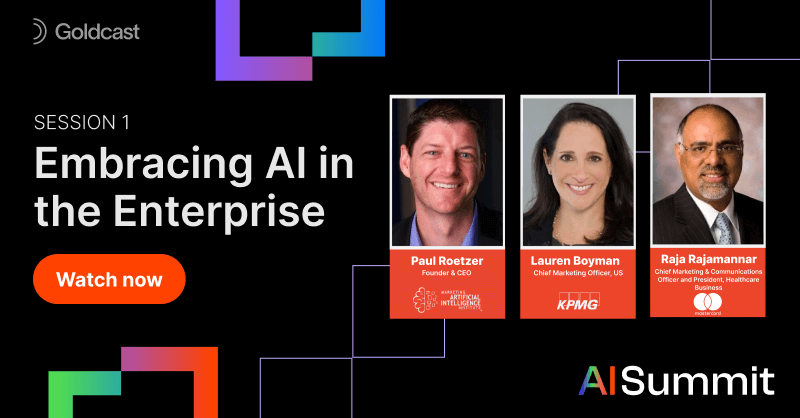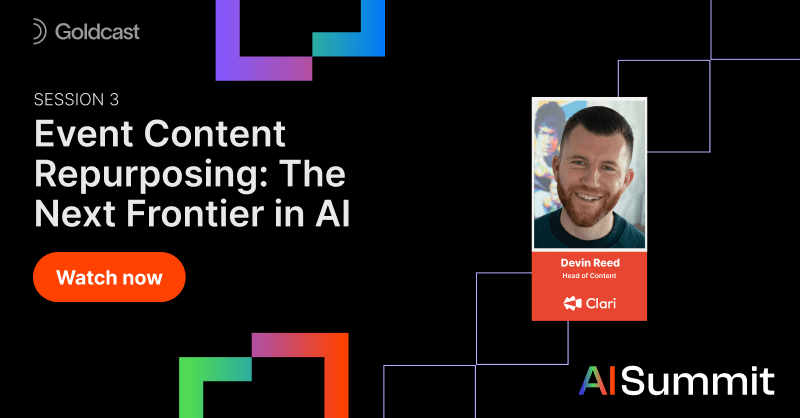AI In The Enterprise: Unlocking Opportunities for Growth and Innovation

Maximize Your Marketing ROI
Join 10,000 other marketers already getting the best tips on running engaging events that boost pipeline and create raving fans.
AI has reached the top of the executive agenda. And if you’re like most business leaders, you’re feeling the pressure. According to KPMG’s latest survey, 70% of CEOs ranked investment in generative AI (GenAI) as a top priority—despite the challenging economic environment. And 52% expect to see a return in the next three to five years.
But capturing the return on AI isn’t easy. To effectively scale AI across the enterprise, you need clear goals and boundaries for exactly how and when to use it.
At our recent AI Summit, we sat down with three experts at the forefront of enterprise level AI adoption. In this article, we’ll dive into their latest best practices for using AI in today’s projects and processes, while testing new impact-driven use cases for tomorrow.

Meeting the urgent call for AI adoption
The sudden rise of GenAI has been felt by everyone—the government, the public, and businesses. Not even the adoption curve for smartphones was as steep as what we’re currently witnessing with GenAI.
“The empowerment it can give you is humongous and the beauty is, it doesn’t cost a lot. It's a very accessible and affordable technology,” explains Raja Rajamannar, Chief Marketing & Communications Office and President, Healthcare Business, at Mastercard. For experts like Raja, GenAI is the most groundbreaking technology since the dawn of the Internet.
However, in many large enterprises, AI adoption is a slow process. Sure, the pilots are happening. But there’s still no clear impact in terms of the teams, processes, and strategies that deliver real value. According to Founder & CEO at Marketing AI Institute Paul Roetzer, this is a common problem. “We're starting to see this pressure to take some action, but oftentimes the marketing leadership isn't really sure what exactly they should be doing,” he says.
Yet enterprise marketing leaders know they need to invest in AI. Lauren Boyman explains:
In 2019, seven out of 10 companies reported no positive return on investment (ROI) from AI due to challenges in deployment. Four years later, 92% of large companies say they are already achieving returns on their data and AI investments.
The reality is we're expected to do more with less, and produce better outcomes. So in my mind, GenAI is really our ticket. It can help us create efficiencies and productivity that we so desperately need,” says Lauren Boyman, Chief Marketing Officer (CMO) at KPMG US.
To satisfy increased demand for AI and secure board level buy-in for future projects, you need a robust structure you can scale. Let’s take a closer look at the key steps experts like Raja, Paul, and Lauren are taking to maximize their investment in AI.
The road to AI implementation: 6 common challenges for enterprises when adopting AI
Today 55% of business leaders say their teams are resistant toward adopting AI. It’s not hard to see why. Fear of job loss, data privacy concerns, intrinsic bias—the risks are real.
But the opportunity is just as great. Rather than shy away from the challenges AI brings, now is the time to face them head-on, with full transparency.
Here are some of the most common challenges preventing AI adoption at scale.
1. Intellectual property (IP) infringement
There is still a large legal gray area at the intersection of AI, patentability, and inventorship. With certain GenAI tools, there’s the possibility that a user’s input data could be output verbatim to another user. It’s also unclear whether a GenAI tool can be named "inventor" on patent applications. Tools like ChatGPT already prohibit users from representing output as human-generated, requiring them to disclose that information in public facing documents.
2. Protecting the company's IP
For large enterprises, the challenge with IP cuts both ways. Mastercard’s “priceless” slogan and timeless tagline, “There are certain things money can’t buy, for everything else there’s Mastercard,” is everywhere in GenAI tools. “Guarding our territory when somebody else is using generative AI, that’s a huge risk,” says Raja.
3. Bias
There’s no denying the intrinsic bias that exists in the very creation of AI. One mistake, and you can damage the brand you’ve worked so hard to build. In a world where biased technology can lead to poor customer experiences and lost revenue, an inclusive and representative approach is a must.
4. Accuracy
By now, it’s widely known that AI can hallucinate. It’s even damaged the credibility of some of the world’s most trusted news publications. Whether it's content for a targeted marketing campaign or a request for proposal (RFP) response, you can’t afford to let the “junk” impact your reputation.
5. Skills gaps
Though somewhat less discussed, another big risk with AI is talent related. Not everybody has the skills to: a.) grasp the concept of machine learning and b.) put it to use for the good of the company. And you don’t want to leave folks that do a good job behind. Closing skills gaps is a top executive-level priority, with 83% of leaders saying their organization is moving quickly on skills development in AI.
6. Lack of practical context
There are a ton of things you can do with AI, but which ones will actually have an impact?
The challenge in leveraging AI isn’t cost or affordability. It’s understanding the real use cases that drive productivity and ROI. To maximize GenAI, you need tools that are integrated within your existing day-to-day workflows and won’t introduce new risks or inefficiencies into your processes.
Simplify AI adoption with 3 best practices for enterprises
To minimize the risks and maximize the return on AI, you need fully aligned teams, clear experimentation boundaries, and an active learning culture.
Now that we’ve covered its limitations, let’s get into the actionable steps you can take to make AI adoption easier.
1. Align the organization
According to our experts, one of the biggest barriers to AI adoption isn’t the known challenges. It’s a lack of comprehension about what’s really possible with machine learning.
To effectively scale AI across the enterprise, your vision must come from within. Communicate enthusiasm about the potential of AI from the top-down. Remind people that AI has created more jobs than it’s taken.
Work to build a culture of learning that starts with the people at the top taking active steps to walk the walk.
Here are some simple ways to help increase buy-in for AI at every level of the business:
- Secure stakeholder buy-In: If buy-in is an issue, engage external experts to demonstrate the possible impact and opportunities of AI. Showcase real examples and clear data.
- Simplify, demystify, then educate: Use digital and applied learning formats to train employees in the basic foundations of machine learning and AI models.
- Build standards and awareness: Educate employees on the possible IP infringement risks, and enlist their help in guarding the business against AI-generated content that could be inaccurate or offensive.
- Create an AI roadmap: Lay out a clear framework for how you’re building pilots and the current projects slated for the next 12 months.
To succeed with AI adoption, the entire team must be aware of both the limitations and the opportunities of emergent technologies.
For leaders like Raja, this means encouraging people to take courses on AI and machine learning via online platforms like Coursera. “The return you get is phenomenal. People are more confident and are beginning to grasp what you can do and what the opportunities are,” he explains.
Paul agrees that trust and support is everything. “The sooner we admit that we're all figuring it out together and get on the same page, the better it's going to be within organizations,” he says.
2. Experiment within boundaries
While the mandate for AI adoption must come from the top down, much of the real innovation comes from the bottom up. That’s why you have to be willing to experiment. “You have designers and writers and email marketers who are just going out and using these tools without a structure being provided by the corporation,” explains Paul.
He uses the following four-question framework to identify tasks that can be accelerated or enhanced through the use of AI:
- Is it data-driven?
- Is it repetitive?
- Is it making a prediction about an outcome or behavior?
- Is it generative?
Despite the rapid rise of tools like ChatGPT, many workers have had little opportunity to use AI as part of their daily roles. At Mastercard, Raja and his team actively encourage experimentation, within set boundaries.
Here’s how that breaks down:
- Set expectations from the top down: Establish both the guidelines and the expectations from the top down. From there, step back and let the team experiment.
- Create an AI department: Assemble a dedicated team tasked with defining the AI strategy, identifying projects, and ensuring the correct utilization of resources.
- Establish security protocols to protect your data: Use encryption and other security measures to guarantee privacy and compliance while using AI.
- Monitor the quality: Pay close attention to the quality of output from GenAI and its effectiveness in your campaigns
- Make it clear that failure is ok: There should be no negative consequences for team members that are actively testing the limits of AI.
While the guidelines and aspiration come top-down, the quality and effectiveness will come from the way your teams apply AI every day at work. Here’s how Raja positions it to his teams:
“We tell folks, you cannot afford to miss the bus. But in our enthusiasm to run, we don’t want to slip and fall either,” he says.

3. Nurture a culture of learning
The beauty of having clear boundaries for AI experimentation is that it fosters an environment where innovation thrives. Make a conscious effort to debunk the jargon, make AI accessible to all employees, and foster a culture where no one is left behind.
Lauren has taken a similar approach and is seeing plenty of internal hand raisers eager to experiment and participate in pilots. She’s even heard from clients who want to co-experiment with their own pilots.
That’s because the leadership team at KPMG US has a scalable set of AI principles in place, including a central innovation agenda to guide their Center of Excellence. “That group's responsible for integrating emerging technologies into existing services, incubating new solutions for clients, enabling new ways of working and, of course, doing so responsibly,” says Laura.
Here are some best practices to ensure your teams can learn and experiment effectively:
- Create an AI Centre of Excellence (COE): Creating a dedicated COE for AI helps the entire organization stay updated with tech advancements, while supporting skill development, and setting clear guidelines for implementation.
- Host training sessions: Empower teams to learn about machine learning, neural language programming (NLP), and the latest AI tools to experiment with.
- Apply AI to existing workflows: Integrate your tools with your existing tech stack and look for ways to use AI to automate repetitive, data-driven tasks.
- Build a system for knowledge sharing: As teams work with different prompts and use cases, they’re going to discover new techniques. Put a system in place to help them share that knowledge across the organization.
This may involve building or onboarding an enterprise-wide tool that can protect your proprietary information. Whatever route you choose, make sure your marketing team is encouraged to work closely with the AI team to harness real results for the business.

Examples of how leading companies are using AI
Once you find out what works, you need to move quickly from experimentation to industrialization. Here are a few examples of how our experts are already using AI.
Generating creative campaigns and programs
You may already know that AI can be used for all types of aspects within the marketing ecosystem, including: insight mining, lead generation, automated testing, and social media trends prediction.
But all of this was before generative AI. Since then, enterprise leaders like Raja have been using GenAI to accelerate manual processes and take their creativity to a whole new level.
He uses an AI-powered RFP response mechanism to take the team’s draft time from six weeks to just four hours. Through the Mastercard Artist Accelerator program, the company helps aspiring artists create music using AI, while taking all the right actions to both avoid infringing on, and also protect, their own IP.
Automating repetitive tasks
For Paul and the team at Marketing AI Institute, it’s all about efficiency. Paul’s podcast is his top channel. It drops every Tuesday without fail, but the process is highly manual—with over 20 steps involved in the production, recording, and promotion process.
“We look at each of those individual steps and say, can AI assist us in this step? For example, on the promotion side, that might mean taking the one hour podcast and cutting it up into five clips for social media.”
The team also uses AI to add captions, generate ideas for questions to ask, and even assist in script writing. Needless to say, the process is now much faster. “AI does all that for us now,” says Paul.
Accelerating the content production process
One of the most effective AI use cases for marketing teams is using GenAI to create derivative assets from existing content. For Lauren and the team at KPMG, this could include first drafts, summaries or keywords, and other outputs that can speed up the content production process.
“Today, we can definitely see gains in efficiencies for individual steps in the process,” says Lauren. Her team serves every corporate buyer with the full breadth of the big four firm’s solutions. They need all the help they can get.
“I think truly the level of transformation that we're going to see is similar to what we saw almost two decades ago when digital martech came to the forefront, because AI has potential to remove a lot of the work effort, which then frees marketers up to think more creatively and push the impact of what marketing can do,” she explains.

Go from idea to implementation with AI
By integrating AI holistically into your operations, and giving careful consideration to the potential pitfalls, your organization stands to gain significant competitive advantages.
But that doesn’t mean AI can do it alone.
We've learned some really important lessons so far. While I can streamline certain aspects of work, there are still elements of creativity, intuition, and emotional connection where human intervention is critical to getting the full job done,” says Lauren.
AI offers the opportunity to effectively complete and speed up key steps in the process, but you still need the human touch to bring it all together.

Transform Your Video Marketing with AI
Stay In Touch
Platform
Resources
© 2025 Copyright Goldcast, Inc. All rights reserved.





 Upcoming Events
Upcoming Events Event Series
Event Series On-Demand Events
On-Demand Events

